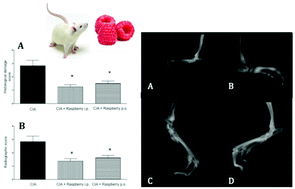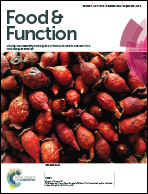Chemical characterization of a red raspberry fruit extract and evaluation of its pharmacological effects in experimental models of acute inflammation and collagen-induced arthritis
Abstract
Berries are an important dietary source of fibres, vitamins, minerals and some biologically active non-nutrients. A red raspberry fruit extract was characterized in terms of phenolic content and the anti-inflammatory properties and protective effects were evaluated in two experimental models of inflammation. The antioxidant potential of the extract, the cellular antioxidant activity and the effects over neutrophils’ oxidative burst were also studied to provide a mechanistic insight for the anti-inflammatory effects observed. The extract was administered in a dose of 15 mg kg−1, i.p. and significantly inhibited paw oedema formation in the rat. The same dose was administered via i.p. and p.o. routes in the collagen-induced arthritis model in the rat. The extract showed pharmacological activity and was able to significantly reduce the development of clinical signs of arthritis and markedly reduce the degree of bone resorption, soft tissue swelling and osteophyte formation, preventing articular destruction in treated animals.



 Please wait while we load your content...
Please wait while we load your content...